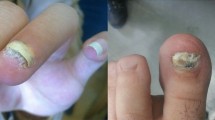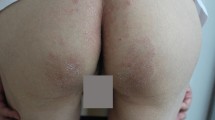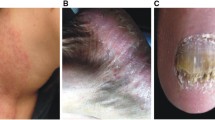Abstract
The first case of Tritirachium oryzae isolated from an Iranian patient is reported. A 44-year-old woman with a lesion in her fingernail was examined for onychomycosis. Direct microscopic examination of the nail clippings revealed fungal filaments and inoculation of portions of the nail clippings on cultures media yielded T. oryzae after 8 days. The isolate was identified as Tritirachium spp. on the basis of gross morphological characteristics of the fungal colony and microscopic characterization of slide cultures. The diagnosis of T. oryzae was confirmed by PCR sequencing of the internal transcribed spacer domain of the rDNA gene. In vitro antifungal susceptibility test demonstrated that the fungus was susceptible to itraconazole and posaconazole. The patient was treated with oral itraconazole.



Similar content being viewed by others
References
Anaissie EJ, McGinnis MR, Pfaller MA. Clinical mycology. Philadelphia: Elsevier Sciences; 2003. p. 463–4.
Zarei Mahmoudabadi A, Zarrin M. Onychomycosis with Aspergillus flavus: a case report from Iran. Pak J Med Sci. 2005;21(4):497–8.
Bonifaz A, Cruz-Agular P, Ponce RM. Onychomycosis by molds. Report of 78 cases. Eur J Dermatol. 2007;17(1):70–2.
Farwa U, Abbasi SH, Mirza IA, Amjad A, Ikram A, Malik N, Hanif F. Non-dermatophyte moulds as pathogens of onychomycosis. J College Physicians Surg Pak. 2011;21(10):597–600.
Zotti M, Machetti M, Persi A, Barabino G, Pardoi A. Onychomycosis: first case due to Aspergillus nomius. Acta Derm Venerol. 2011;91:591–2.
Dhib I, Fathallah A, Yaacub A, Zemni R, Gaha R, Said MB. Clinical and mycological features of onychomycosis in central Tunisia: a 22 years retrospective study (1986–2007). Mycoses. 2013;56(3):273–80.
Hwang SM, Suh MK, Ha GY. Onychomycosis due to non dermatophytic molds. Ann Dermatol. 2012;24(2):175–80.
Cursi IB, Freitas LBCR, Neves MLPF, Silva IC, Orofino-Costa R. Onychomycosis due to Scytalidium spp.: a clinical and epidemiologic study at a University Hospital in Rio de Janeiro, Brazil. An Bras Dermatol. 2011;86(4):689–93.
Gupta AK, Ryder JE, Summerbell RC. The diagnosis of non-dermatophyte mold onychomycosis. Int J Dermatol. 2003;42(4):272–3.
Moraes RNR, Ribeiro MCT, Nogueira MCL, Cunha KC, Soares MMCN, Almeida MTG. First report of Tritirachium oryzae infection of human scalp. Mycopathologia. 2010;169:277–9.
Kwong-Chung KJ, Bennett J. Medical mycology. Philadelphia: Lea and Febiger; 1992. p. 807.
Rodrigues MM, Laibson P. Exogenous corneal ulcer caused by Tritirachium roseum. Am J Ophthalmol. 1975;80(5):804–6.
Najafzadeh MJ, Badali H, Illnait-Zaragozi MT, de Hoog GS, Meis JF. In vitro activities of eight antifungal drugs against 55 clinical isolates of Fonsecaea spp. Antimicrob Agents Chemother. 2010;54:1636–8.
Najafzadeh MJ, Sun J, Vicente V, Xi L, van den Ende AH, de Hoog GS. Fonsecaea nubica sp. nov, a new agent of human chromoblastomycosis revealed using molecular data. Med Mycol. 2009;48(6):800–6.
de Hoog GS, Gerrits van den Ende AH. Molecular diagnostics of clinical strains of filamentous Basidiomycetes. Mycoses. 1998;41(5–6):183–9.
Masclaux F, Gueho E, de Hoog GS, Christen R. Phylogenetic relationships of human–pathogenic Cladosporium (Xylohypha) species inferred from partial LS rRNA sequences. J Med Vet Mycol. 1995;33(5):327–38.
Najafzadeh MJ, Vicente VA, Sun J, Meis JF, de Hoog GS. Fonsecaea multimorphosa sp. nov, a new species of Chaetothyriales isolated from a feline cerebral abscess. Fungal Biol. 2011;115(10):1066–76.
Rippon JW. Medical mycology: the pathogenic fungi and the pathogenic actinomycetes. 2nd ed. Philadelphia: The W.B. Saunders Co.; 1988. p. 213–4.
Khosravi AR, Mansouri P. Onychomycosis in Tehran, Iran: prevailing fungi and treatment with itraconazole. Mycopathologia. 2001;150(1):9–13.
Bassiri-Jahromi S, Khaksar AA. Nondermatophytic moulds as a causative agent of onychomycosis in Tehran. Indian J Dermatol. 2010;55(2):140–3.
Chadeganipour M, Nilpour S, Ahmadi G. Study of onychomycosis in Isfahan, Iran. Mycoses. 2010;53:153–7.
Hashemi SJ, Gerami M, Zibafar E, Daei M, Moazeni M, Nasrollahi A. Onychomycosis in Tehran: mycological study of 504 patients. Mycoses. 2010;53(3):251–5.
Aghamirian MR, Ghiasian SA. Onychomycosis in Iran: epidemiology, causative agent and clinical features. Nihon Ishinkin Gakkai Zasshi. 2010;51:23–9.
de Hoog GS, Guarro J, Gene J, Figueras MJ. Atlas of clinical fungi. 2nd ed. Utrecht/Reus: Centraalbureau voor Schimmelcultures/Universitat Rovira i Virgili; 2000. p. 995.
Zotti M, Machetti M, Perotti M, Barabino G, Persi A. A new species, Aspergillus persii, as an agent of onychomycosis. Med Mycol. 2010;48:656.
Acknowledgments
The authors would like to thank the personnel of the Medical Mycology and parasitology Laboratory of Imam Reza Hospital, Mashhad University of Medical Sciences for their help and reviewer for review of the manuscript.
Author information
Authors and Affiliations
Corresponding author
Rights and permissions
About this article
Cite this article
Naseri, A., Fata, A. & Najafzadeh, M.J. First Case of Tritirachium oryzae as Agent of Onychomycosis and Its Susceptibility to Antifungal Drugs. Mycopathologia 176, 119–122 (2013). https://doi.org/10.1007/s11046-013-9653-0
Received:
Accepted:
Published:
Issue Date:
DOI: https://doi.org/10.1007/s11046-013-9653-0




